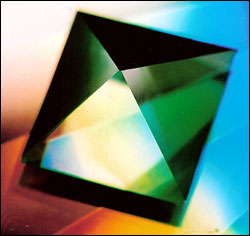
Optical Elements for Lasers
Elk Industries, R-K Manufacturing
MELBOURNE, Fla., Feb. 21, 2007 -- Elk Industries LLC announced the release of its patented optical elements for lasers, a four-sided pyramid made of optical material that the company said can replace many optical elements with a single device.
The pyramid can be used as a O° reflector, reflecting laser or as a prism to break up a light spectrum into its component colors, such as with a diffraction grating (in a different orientation) or ordinary prism.
 "This achievement marks a major milestone in the advancement of optics and laser systems," said Elk Industries owner Robin Elkins, an inventor and engineer. "More uses are discovered as time moves forward. Just the concept that one optical element can perform so many tasks in an optical system or laboratory represents a huge savings in cost, labor and materials."
"This achievement marks a major milestone in the advancement of optics and laser systems," said Elk Industries owner Robin Elkins, an inventor and engineer. "More uses are discovered as time moves forward. Just the concept that one optical element can perform so many tasks in an optical system or laboratory represents a huge savings in cost, labor and materials."
Elkins said the elements eliminate the need for coatings, because R-K Manufacturing Co. (which is now a division of Elk Industries) was quite concerned about laser damage thresholds being too low for optics in the laboratory.
"Many expensive and difficult to obtain high-energy laser mirrors were damaged or destroyed because of the lack of having optical elements for lasers -- this invention -- before these pyramids were made successfully and put into practice," said Elkins. "The way that these optical elements are able to withstand so much power and/or energy relates to their properties of exhibiting total internal reflection (TIR) at certain angles, thus eliminating the laser damage problems associated with coatings."
Elkins said if coatings are desired, they also fall under the patent, and can be applied to any of the desired surfaces of the optical elements for lasers pyramid.
It took Elkins more than seven years to obtain the US Patent, 5,825,802, "Optical Elements for Lasers" which he said was the subject of "intense, elaborate, and thorough examination and opposition" during the patent process. He has been awarded six other patents for his inventions.
Elkins said he has developed more uses for the geometry of optical elements for lasers. "This is where the pyramid is made of an optical laser material itself, such as Nd:YAG, and can be optically pumped with radiant flux from an appropriate laser diode, flashlamp or arclamp. In this application, more usable output is obtained per unit of 'input' pump radiation. It is more efficient than other types of laser geometries, and therefore requires less laser material to extract greater amounts of laser power and energy. The improvement is commonly as high as one whole order of magnitude when compared to other geometries -- such as disks, slabs, or rods -- yet allows for adequate cooling if the laser is property designed," he said.
The optical elements are currently in production, and are typically made of either BK-7, fused silica or fused quartz (optical glasses). A typical "basic optical element" is made with a 1 in. x 1 in. square base, or 10 mm x 10 mm base, but can be made to smaller or larger sizes. The "roof angle" is 90°.
The Nd:YAG crystals are commonly made with 4 mm x 4 mm square base, and roof angle of 90°.
Delivery is typically from stock to four weeks. For more information, visit: www.elkindustries.com; e-mail: laserob@aol.comElk Industries LLC
2117 South Babcock St., Suite 106
Melbourne, FL 32901
Phone: (321) 259-8114
Fax: (321) 723-2739
/Buyers-Guide/Elk-Industries-R-K-Manufacturing/c4282
Published: February 2007
From the Photonics Marketplace
CoatingsElk Industriesindustriallaser mirrorsmirrorsNd:YAGopticaloptical elementOpticsphotonicsPrismsProductspyramidreflectionLasers